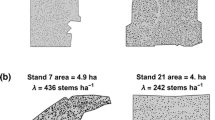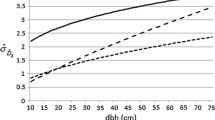Abstract
Stem diameter is one of the most common measurements made to assess the growth of woody vegetation, and the commercial and environmental benefits that it provides (e.g. wood or biomass products, carbon sequestration, landscape remediation). Yet inconsistency in its measurement is a continuing source of error in estimates of stand-scale measures such as basal area, biomass, and volume. Here we assessed errors in stem diameter measurement through repeated measurements of individual trees and shrubs of varying size and form (i.e. single- and multi-stemmed) across a range of contrasting stands, from complex mixed-species plantings to commercial single-species plantations. We compared a standard diameter tape with a Stepped Diameter Gauge (SDG) for time efficiency and measurement error. Measurement errors in diameter were slightly (but significantly) influenced by size and form of the tree or shrub, and stem height at which the measurement was made. Compared to standard tape measurement, the mean systematic error with SDG measurement was only −0.17 cm, but varied between −0.10 and −0.52 cm. Similarly, random error was relatively large, with standard deviations (and percentage coefficients of variation) averaging only 0.36 cm (and 3.8%), but varying between 0.14 and 0.61 cm (and 1.9 and 7.1%). However, at the stand scale, sampling errors (i.e. how well individual trees or shrubs selected for measurement of diameter represented the true stand population in terms of the average and distribution of diameter) generally had at least a tenfold greater influence on random errors in basal area estimates than errors in diameter measurements. This supports the use of diameter measurement tools that have high efficiency, such as the SDG. Use of the SDG almost halved the time required for measurements compared to the diameter tape. Based on these findings, recommendations include the following: (i) use of a tape to maximise accuracy when developing allometric models, or when monitoring relatively small changes in permanent sample plots (e.g. National Forest Inventories), noting that care is required in irregular-shaped, large-single-stemmed individuals, and (ii) use of a SDG to maximise efficiency when using inventory methods to assess basal area, and hence biomass or wood volume, at the stand scale (i.e. in studies of impacts of management or site quality) where there are budgetary constraints, noting the importance of sufficient sample sizes to ensure that the population sampled represents the true population.




Similar content being viewed by others
References
Auclair, D. (1986). Measurement errors in forest biomass estimation. In H. Wharton & T. Cunia (Eds.), Estimating tree biomass regressions and their error (pp. 1–13). Broomall, USDA: NE-GTR-117 Forest Service, Northeastern Forest Experimental Station.
Barker, J. R., Bollman, M., Ringold, P. L., Sackinger, J., & Cline, S. P. (2002). Evaluation of metric precision for a riparian forest survey. Env. Monit. Assess., 75, 51–72.
Behre, C. E. (1926). Comparison of diameter tape and calliper measurements in second-growth spruce. Journal of Forestry, 24, 178–182.
Berger, A., Gschwantner, T., McRoberts, R. E., & Schadauer, K. (2014). Effects of measurement errors on individual tree stem volume estimates for the Austrian National Forest Inventory. Forest Science, 60, 14–24.
Biging, G. S., & Wensel, L. C. (1988). The effect of eccentricity on the estimation of basal area increment of coniferous trees. Forest Science, 34, 621–633.
Chave, J., Condit, R., Aguilar, S., Hernandez, A., Lao, S., & Perez, R. (2004). Error propagation and scaling for tropical forest biomass estimates. Phil. Trans. R. Soc. Lond. Series B-Biol. Sci., 359, 409–420.
Cunia, T. (1986). Error of forest inventory estimates: its main components. In H. Wharton & T. Cunia (Eds.), Estimating tree biomass regressions and their error (pp. 1–13). Broomall, USDA: NE-GTR-117 Forest Service, Northeastern Forest Experimental Station.
Dot EE. 2016. Guidelines for field sampling of biomass, version 1.0. The Department of the Environment, Canberra.
Elzinga, C., Shearer, R. C., & Elzinga, G. (2005). Observer variation in tree diameter measurements. Western Journal of Applied Forestry, 20, 134–137.
Gertner, G. Z. (1990). The sensitivity of measurement error in stem volume estimation. Canadian Journal of Forest Research, 20, 800–804.
Gertner, G., & Dzialowy, P. J. (1984). Effects of measurement errors on an individual tree-based growth projection system. Canadian Journal of Forest Research, 14, 311–316.
Gregoire, T. G., Zedaker, S. M., & Nicholas, N. S. (1989). Modeling relative error in stem basal area estimates. Canadian Journal of Forest Research, 20, 496–502.
Holdaway, R. J., McNeill, S. J., Mason, N. W. H., & Carswell, F. E. (2014). Propagating uncertainty in plot-based estimates of forest carbon stock and carbon stock change. Ecosystems, 17, 627–640.
Kalliovirta, J., Laasasenaho, J., & Kangas, A. (2005). Evaluation of the laser-relascope. Forest Ecology and Management, 204, 181–194.
Kitahara, F., Mizoue, N., & Yoshida, S. (2009). Evaluation of data quality in Japanese National Forest Inventory. Env. Mont. Assess., 159, 331–340.
Kitahara, F., Mizoue, N., & Yoshida, S. (2010). Effects of training for inexperienced surveyors on data quality of tree diameter and height measurements. Silva Fenn., 44, 657–667.
Magalhãe, T. M., & Seifert, T. (2015). Estimation of tree biomass, carbon stocks, and error propagation in Mecrusse Woodlands. Open J. For., 5, 471–488.
McRoberts, R. E., Hahn, J. T., Hefty, G. J., & Van Cleve, J. R. (1994). Variation in forest inventory field measurements. Canadian Journal of Forest Research, 24, 1766–1770.
Methley, J. (2001). Getting the measure of your timber: let’s start with diameter. For. Brit. Timber, 30, 26–28.
Molto, Q., Rossi, V., & Blanc, L. (2012). Error propagation in biomass estimation in tropical forests. Meth. Ecol. Evo., 4, 175–183.
Moran, L., & Williams, R. A. (2002). Comparison of three dendrometers in measuring diameter at break height. N. J. App. For., 19, 28–33.
Myers, A. C. (1961). Variation in measuring diameter as breast height of mature ponderosa pine. Rocky Mountain Forest and Rage Experiment Station. Res. Note., 67, 1–3.
Nester, M. R. (1981). Assessment and measurement errors in slash pine research plots. Department of Forestry (Vol. 26, p. 10). Queensland: Technical Paper.
Omule, S. A. Y. (1980). Personal bias in forest measurements. Forest Chron., 56, 222–224.
Paul, K., Roxburgh, S., Raison, J., Larmour, J., England, J., Murphy, S., Norris, J., Ritson, P., Brooksbank, K., Hobbs, T., Neumann, C., Lewis, T., Read, Z., Clifford, D., Kmoch, L., Rooney, M., Freudenberger, F., Jonson, J., Peck, A., Giles, R., Bartle, J., McArthur, G., Wildy, D., Lindsay, A., Preece, N., Cunningham, S., Powe, T., Carter, J., Bennett, R., Mendham, D., Sudmeyer, R., Rose, B., Butler, D., Cohen, L., Fairman, T., Law, R., Finn, T., Brammar, M., Minchin, G., van Oosterzeeand, P,. Lothian, A.. 2013. Improved estimation of biomass accumulation by environmental planting and mallee plantings using FullCAM. Report for Department of Environment. CSIRO Sustainable Agriculture Flagship, Canberra.
Shettles, M., Temesgen, H., Gray, A. N., & Hilker, T. (2015). Comparison of uncertainty in per unit area estimates of aboveground biomass for two selected model sets. Forest Ecology and Management, 354, 18–25.
Vastaranta, M., Melkas, T., Holopainen, M., Kaartinen, H., Hyyppä, J., & Hyyppä, H. (2008). Comparison of different laser-based methods to measure stem diameter (pp. 17–19). Edinburgh: SilviLaser.
Weaver, S. A., Ucar, Z., Bettinger, P., Merry, K., Faw, K., & Cieszewski, C. J. (2015). Assessing the accuracy of tree diameter measurements collected at a distance. Croat. J For. Eng., 36, 73–83.
West, P. W. (2009). Tree and forest measurement. Berlin: Springer-Verlag.
Wilson, E. R., Murray, J., Ryding, I., & Casson-du Mont, E. C. (2007). Comparison of three tools for measuring tree diameter in stands of different age and stem size. Quart. J. For., 101, 267–274.
Acknowledgements
The project was funded by the Department of the Environment and Energy. We thank Eva Damm, Tom Fairman, and Rob Law for the assistance with field measurement. Craig Macfarlane, Jenny Sinclair, Jerome Chave, and Sadanandan Nambiar are thanked for their reviews of the manuscript.
Author information
Authors and Affiliations
Corresponding author
Rights and permissions
About this article
Cite this article
Paul, K.I., Larmour, J.S., Roxburgh, S.H. et al. Measurements of stem diameter: implications for individual- and stand-level errors. Environ Monit Assess 189, 416 (2017). https://doi.org/10.1007/s10661-017-6109-x
Received:
Accepted:
Published:
DOI: https://doi.org/10.1007/s10661-017-6109-x




